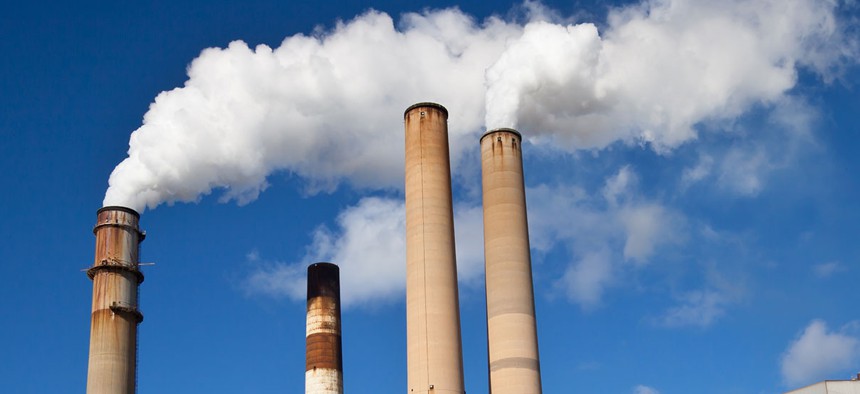
Viktorus/Shutterstock.com
EPA Worked To Shield The White House Climate Plan From The Courts
Legal experts say the new rules on power plants are destined for the Supreme Court, but the EPA tweaked the policy to help improve its chances.
President Obama wants his 'Clean Power Plan' to stand the test of time —and the many legal challenges coming its way.
To give it a better shot of surviving the judicial system, the Environmental Protection Agency has made several important changes to the rule regulating greenhouse-gas emissions from power plants.
Among other changes from earlier proposals, the EPA gave states and power plants more time to comply, and offered a more detailed explanation of the rationale for certain provisions.
"Generally the EPA in the Obama administration … has been aware of potential vulnerabilities and has tried to bulletproof its rules. And that's not something we always expect from the EPA," said Jonathan Adler, a law professor at Case Western Reserve University who specializes in EPA cases.
But the rule's biggest vulnerability is still pretty big, legal experts say. Critics will not only take aim at the way the EPA is regulating power plants, but will argue in court that the agency doesn't have the legal authority to issue these rules at all.
"This final rule adopts a radical, unprecedented regime, transforming EPA from an environmental regulator into a central planning authority for electricity generation," said West Virginia Attorney General Patrick Morrisey, who led one failed lawsuit against an earlier draft of the regulations and has promised to file a new challenge soon.
A competing group of nine state attorneys general, on the other hand, offered their support to the EPA on Monday, saying the new rules were "firmly grounded in the law" and the result of "a multi-year stakeholder process that draws heavily on strategies that states have used to cut power plant emissions."
The EPA has at least tried to give the impression that it listened to its critics when finalizing its new rules on carbon emissions from power plants, Adler said.
It scrapped an earlier proposal to measure progress, in part, based on whether consumers use energy more efficiently. Critics saw that metric as a major overreach by the EPA, arguing that the agency doesn't have the authority to regulate how consumers use electricity. It's gone from the final rules.
Fourteen states sued the EPA last year over its proposed rules, arguing in part that the plan would unconstitutionally "commandeer" them into doing the federal government's work for it. The states' suit was dismissed because the regulations hadn't been finalized yet. It'll be back—West Virginia's Morrisey has already announced his plans to revive the challenge.
But the EPA sought to head off that argument this time, clarifying in its final rules that if states don't set up their own plans to reduce carbon emissions, the agency will step in to do the job itself. That structure is well-established, Adler said.
"Saying to a state, 'Do our stuff or we'll do it, and you won't like it when we do it'—that's been around for a long time," he said.
But none of those changes directly addresses the heart of the legal challenge to the Clean Power Plan: the argument that the EPA simply doesn't have the authority to regulate emissions from coal-fired power plants, no matter how much time it gives them to comply, or how it tries to lean on the states for help.
That was the centerpiece of the 14 states' lawsuit last time, and none of the changes EPA made to its final rules will prompt them to change that strategy, Adler said. And the argument remains the biggest threat to the new plan, because it has the potential to stop the new standards altogether, rather than simply forcing a change around the margins.
The EPA's new rules rely on an authority it hasn't used very often, and which exists in two places within the Clean Air Act. One section would allow the EPA to regulate coal plants. The other cannot be used to regulate facilities that are also regulated by a different part of the act—which coal-burning power plants are.
Some of the policy changes the EPA has made to the Clean Power Plan might help persuade the courts that it's relying on the right part of the law, Adler said—and some of the criticisms about federalism and burdensome regulations might help persuade the courts that the EPA is acting outside its authority.
Several legal experts have also noted that part of the Supreme Court's recent decision upholding Obamacare's insurance subsidies could haunt the EPA's defense of the Clean Power Plan. Although the Court upheld the health care law's subsidies, it decided not to rely on the doctrine known as "Chevron" deference—which says that when a statute is ambiguous, the courts will often defer to the relevant agency's interpretation.
Obamacare's subsidies were a question of "economic and political significance" too important for agency interpretation, Chief Justice John Roberts wrote in the Court's majority opinion. And critics will argue that the EPA's new regulations are also too important for Chevron deference.
Adler helped devise the challenge to Obamacare's subsidies, and he says the EPA also isn't entitled to deference from the courts. Chevron gives executive agencies some room to interpret statutes that aren't clear, he said, but that's different from deciding which part of a conflicting statute is actually the law.
"It's not a question of, 'What does this statutory provision mean?' It's a question of, 'What is the relevant statutory provision?' " Adler said. "Here, the underlying question is, what did Congress actually do?"
(Image via Viktorus/Shutterstock.com)






